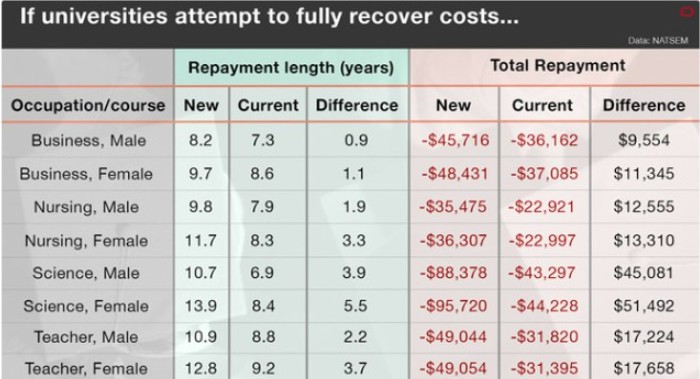
The public rate of return from tertiary education in Australia is twice the rate of return to the individual, a Fairfax Media analysis of figures from the Organisation for Economic Co-operation and Development shows. The data measures the return on investment based on taxes and other financial benefits…
For every public dollar put towards the cost of higher education, a man repays $6 through higher taxes and reduced unemployment benefits. By contrast, the man himself – who benefits personally from higher earnings and higher chances of employment – gets back only $3.20 for every dollar he pays for the cost of his education.
A woman in Australia repays $4.40 for every public dollar spent on her education while her private return is $2.50 per dollar.
At the same time, tertiary students in Australia already contribute far more towards the cost of their education – and receive far less individual benefit – than students across the OECD. Students in Australia contribute 55 per cent of the direct cost of their tertiary education (ie. tuition fees), compared to 30 per cent across the OECD, according to the data.
This analysis raises big question marks around the Government’s deregulation of university fees and its 20% cut to university funding, which will likely see fees double for some courses.
As Chris noted last week, the University of Western Australia has already announced that it would charge an annual fee of $16,000 for the five basic undergraduate courses it offers, which is around double the current HELP rate for most undergraduate degrees.
What is most concerning is that the courses that are most likely to be affected by fee increases are also those that offer the biggest public benefits (and smallest private benefits), such as science, teaching and nursing.
In June, the National Centre for Social and Economic Modelling (NATSEM), which is attached to the University of Canberra, released estimates of how the May Budget’s changes to university fees are likely to impact on various courses, and found that the impact would “be felt most strongly for low-pay occupations such as nursing or education, and across the board the impacts are larger for females”. The modelling “assumed that students will face a repayment interest rate of 5% which is around twice that of the CPI (the existing indexation) but lower than the typical 10 year Treasury bond rate (the proposed loan interest rate) of 6% over the past decade” (see below table).
Equity issues aside, there is the risk that the Coalition’s university fee changes could lead to shortages of essential workers like teachers and nurses. A shortage of nurses, in particular, is precisely what you do not want as the population ages.


